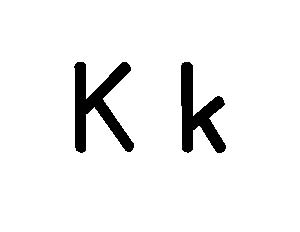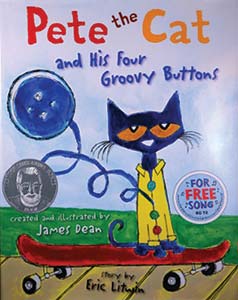Oral language, Letter knowledge
Children will strengthen their comprehension of information presented in a book read aloud and increase the number of novel words they understand. Children will also identify and name the letter K.


New:
Review:
Be Prepared: This is the second of three repeated readings of a book with children. Today’s session focuses on children’s comprehension of information presented in the book, especially connections to children’s experiences. The session also helps children understand more novel words. From the list of novel words you identified prior to your first reading of the book, select 4–6 words to define for children today. Remember, it is okay to select words that a few children may know if you anticipate most children do not understand the word’s meaning. See the Language/Literacy section of the ELM User Guide: 3–5 Years for additional information on how to select and define novel words.
 [Display letter K card.]
[Display letter K card.]
What is the name of this letter?
[Point to the uppercase letter K on the letter card.]
Am I pointing to the uppercase or to the lowercase letter K?
Now let’s spend some time with our book.
[See Week 3, Day 3 of Language/Literacy for a description and examples of how to approach today’s book reading. Key aspects are summarized below:
Number knowledge
Children will strengthen their understanding of how to subtract.


Review:

Be Prepared: Today’s activity requires a visual to illustrate subtraction. Use a flannel board and four circles cut from felt to represent Pete the Cat’s four buttons.
Yesterday we subtracted as we played a game called Musical Chairs. What happened each time a child did not find a chair? (we subtracted one from the number of children playing the game)
[Display book cover.]
Today we will read a book called Pete the Cat and His Four Groovy Buttons. The book was written and illustrated by James Dean and Eric Litwin.
Have you ever read a Pete the Cat book before?
 Pete loves his four groovy buttons. But the buttons start to fall off of his shirt! We will subtract Pete’s buttons as we read our book.
Pete loves his four groovy buttons. But the buttons start to fall off of his shirt! We will subtract Pete’s buttons as we read our book.
[Place four felt circles on the flannel board.]
We will pretend that these circles are Pete’s buttons. We will subtract one of our buttons each time Pete loses a button in the book.
[As you read the book, stop to count Pete’s buttons on each page. Each time Pete loses a button, explain that when one button pops off, we can subtract a circle from our flannel board. Remind children that subtract means to take away something from a group of things. Ask the following questions each time Pete loses a button:
Continue removing buttons from the flannel board as Pete loses buttons in the book.
Each time you get to the part where Pete chants, “My buttons, my buttons . . .” invite children to say it along with you.]
Today we read a book called Pete the Cat and His Four Groovy Buttons. In the book, Pete kept losing his buttons. How many buttons did he have at the beginning of the book? (four) How many did he have left at the end? (zero) We subtracted each time Pete lost a button and then found out how many buttons Pete had left.
Extra support
Enrichment
Provide a basket of large buttons. Fill a bucket with *small numeral cards 1–5. Invite pairs of children to choose a numeral card and then count out the corresponding number of buttons. After both children have the correct number of buttons, encourage them to subtract a number of buttons from their group to find out how many are left.
*Printables provided
Provide the flannel board and felt buttons used during today’s activity. Encourage school-age children to read the book as younger children take turns manipulating the felt buttons as they subtract.
Knowledge of habitats
Children will understand types of food eaten by animals in a rainforest.


New:

We are learning about plants and animals that live in a rainforest. We know that animals live on the rainforest floor and above the rainforest floor. Animals in the rainforest need to find food wherever they live.
What types of things do you think animals eat in a rainforest?
 Animals in the rainforest find plants, insects, or other animals to eat. These things are food for animals to eat. Some food can be found on the rainforest floor, and some food can be found in the trees and plants above the rainforest floor. Some of the trees and other plants grow fruit, nuts, and flowers that animals can eat.
Animals in the rainforest find plants, insects, or other animals to eat. These things are food for animals to eat. Some food can be found on the rainforest floor, and some food can be found in the trees and plants above the rainforest floor. Some of the trees and other plants grow fruit, nuts, and flowers that animals can eat.
[Display picture of a toucan.]
This is a picture of a bird that lives in the rainforest. This bird is called a toucan. A toucan is a bird with bright feathers and a large beak.
The large beak on a toucan is good for grabbing and breaking open fruit the toucan finds in trees and other plants. Toucans also eat berries, insects, snakes, and lizards. The toucan grabs food with its beak and throws the food into the air. Then the toucan catches the food with its beak and eats it.
[In the picture of the toucan, point to the berry being tossed into the air.]
Why do you think a toucan tosses its food into the air? (it needs to toss the food to get it into its mouth)
Let’s pretend we are a toucan tossing a berry into the air with our beak and then catching it with our beak to eat!
[Encourage children to pretend to be a toucan using its beak to toss and then eat a berry.]
Animals in the rainforest eat many types of food they find in the trees and other plants. What is one type of food a rainforest animal eats? (plants, other animals)
Extra support
Enrichment
Supply various books about the rainforest. Examples: The Umbrella Tree by Jan Brett, The Rainforest Grew All Around by Susan K. Mitchell, Over in the Jungle by Marianne Berkes. Invite children to draw rainforest plants and animals in their science journals. Encourage children to dictate a label or description you can write at the bottom of their drawing.
Provide foods for lunch or snack that a rainforest animal might eat. Examples: nuts, berries, salad, bananas.
Being Responsible
Social-Emotional
Skill and Goal
Personal responsibility
Children will understand what it means to make a good decision.
Materials
Needed
*Printables provided
Key
Concepts
Review:
We are learning about making decisions. We know that a decision is a choice we make about something after we think about it. What decisions have you made today?
[Follow-up prompts, if necessary: “Did you decide what clothes to wear today?” “Did you decide what to eat for breakfast?” “Did you decide what to play with when you arrived in our classroom?”]
[Display picture of child sharing. Point to the older boy in the picture.]
This is Alejandro. Alejandro is sharing a toy with his brother.
Do you think Alejandro made a good decision to share a toy with his brother? Why? (he and his brother can make something together, younger brother likes to play with and learn from Alejandro)
[Display picture of child with a hurt elbow.]
This is a picture of Carlos. Carlos ran in the classroom and fell down. Now Carlos has a hurt elbow.
[Display picture of children engaged in dramatic play.]
The children in this picture are in the housekeeping center. The two older girls are helping the younger girl cook something.
Are the children making good decisions? Why?
[Display picture of a child making a mark on another child’s paper.]
This is a picture of Sofia drawing a line on Andrew’s paper. Sofia did not ask Andrew if she could draw a line on his paper. Andrew got upset and yelled at Sofia. He told Sofia that he would hit her if she marked on his paper again.
Sometimes it is hard to make a good decision when we are angry or frustrated.
What are some things we can do to help us make a good decision when we are angry or frustrated? (calm down by taking deep breaths or sitting quietly for a while)
Do we always make good decisions? (no!) We have to work hard to think about our choices and decide whether one of our choices is a better decision. Sometimes we need to calm down so we can make a good decision.
Scaffolding Tips
Extra support
Enrichment
Center Activity
Supply child-friendly cleaning materials. Examples: small dust pan and small broom, washcloths and a small bucket with soapy water. Encourage children to practice making helpful decisions by cleaning up any messes they find in the classroom. Show children how to wring out washcloths to prevent dripping water.
Family Child Care
Invite a different child each day to decide on one snack to offer all children. The snack decision should be a consideration of two choices you offer. Encourage the child who chooses the snack to explain to the other children why he/she decided on the snack from the two choices available.